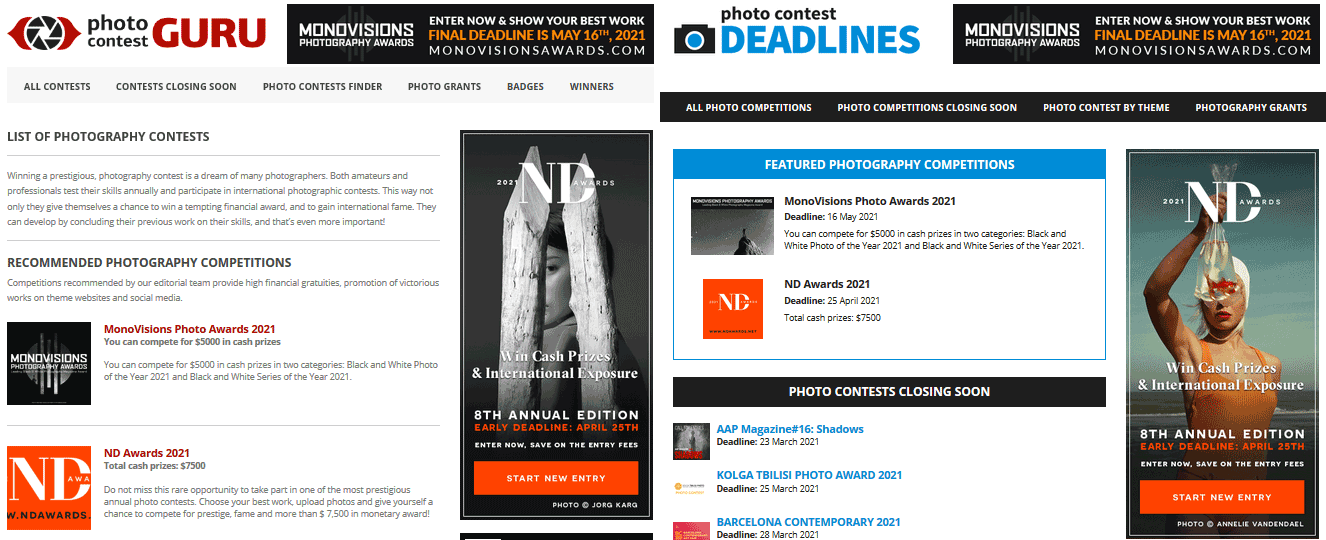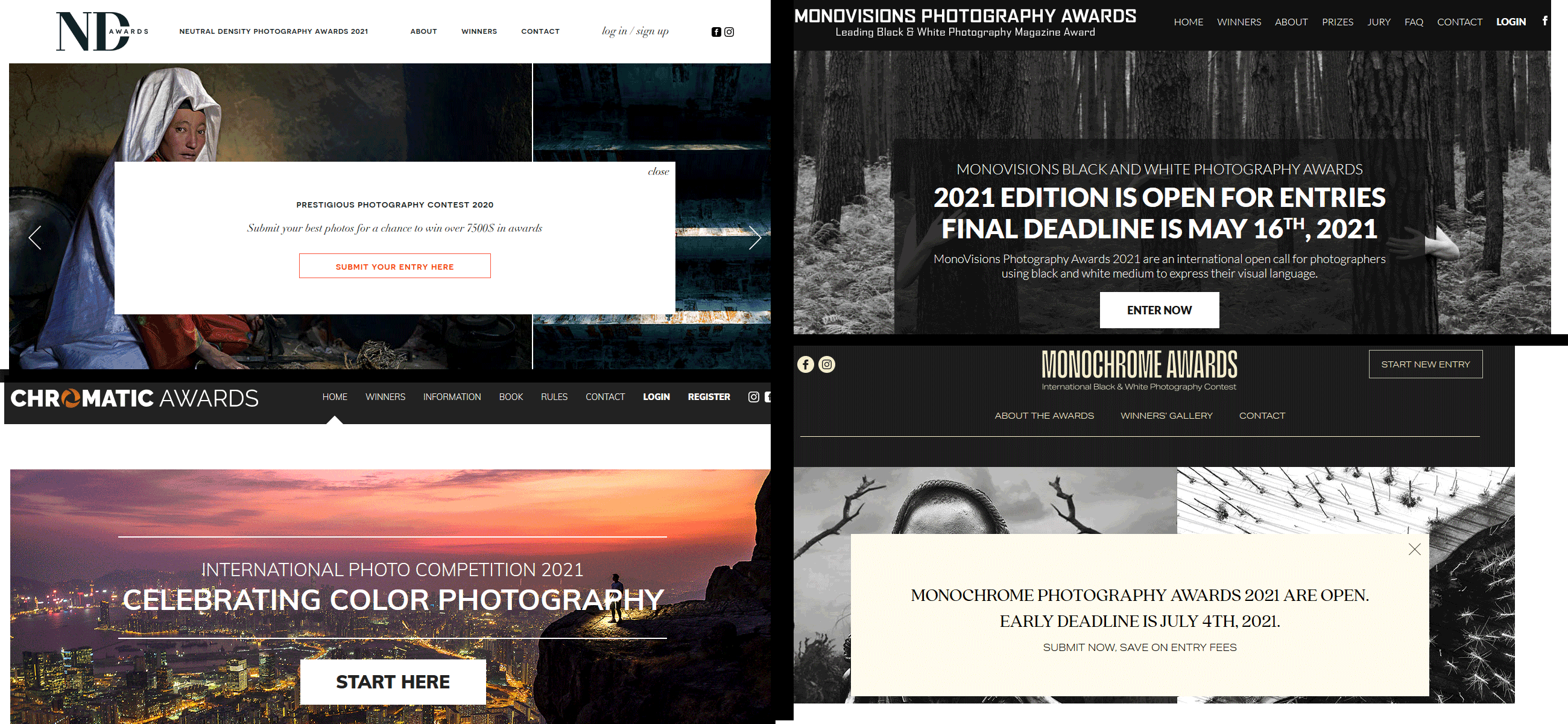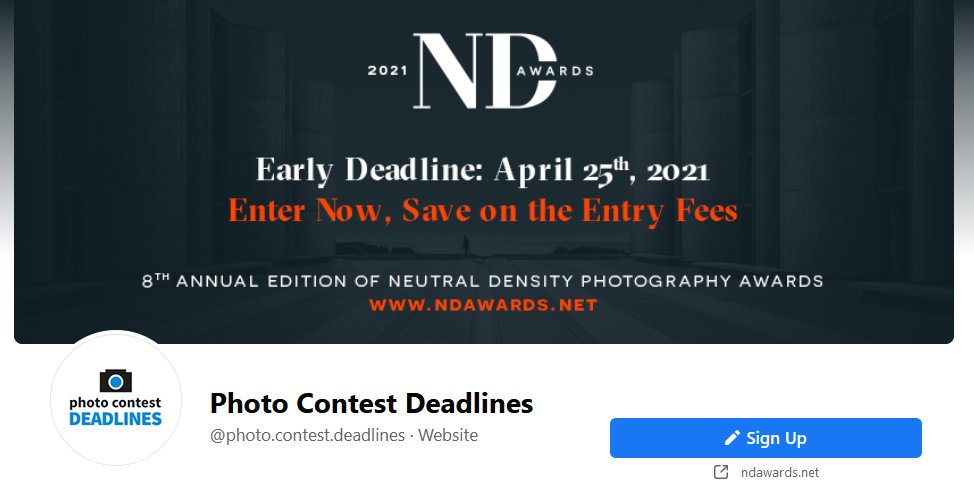Online photo contest directories, with financial links to photo competition entrepreneurs, are being used as a marketing platform to elevate the profile and visibility of dubious contests. 
Inside Imaging found two prominent online photo competition directories, Photo Contest Guru and Photo Contest Deadlines, are hosted on the same servers as a stable of international photo competitions which are shrouded with secrecy. Both directories also aggressively market these photo contests.
More photo contests, more money
In 2018 the brilliantly-named International Photographer of the Year (IPOTY) and the Monochrome Awards were both outed for listing judges who had no involvement with the contests.
Renowned judges lend credibility and legitimacy to contests, and this is why there is a major effort to present an esteemed judging panel. But when a photographer is listed as a contest judge, but has no real role, it’s misleading to entrants and a major lack of contest integrity. There is potentially a legal argument surrounding false advertising. Such was the case with IPOTY and the Monochrome Awards.
Three more for-profit contests, Fine Art Photography Awards, ND Awards, and MonoVisions Awards, were then revealed to be hosted on the same server or connected via a Google Analytics. All five photo contests lack basic details regarding who runs or operates these businesses.
Unfortunately in the murky world of photo contests, this tends to be the rule rather than the exception.
PDN linked the contests to a Polish-born, London-based photographer, Martin Stavars, who also used the alias Sebastian Stavars, through Google Analytics accounts and cached web pages.
The contests share more similarities, such as using a similar website template, and having cash prizes with no brand sponsorship. The ND Awards top prize is US$2500, MonoVisions is US$3000, Monochrome is US$2000, and so on.
The topic was re-visited this year by Dpreview, after it published a gallery of the 2020 Monochrome Awards awards. Two judges both highlighted an extremely dubious judging process – both graded under 1000 images of the apparent 7000 entries. It was unclear to them how a winner was ultimately chosen.
But what’s more telling is none of the contests, or their mysterious organisers, have responded to the various media claims. No one has stepped up to dismiss or clear the allegations. If it looks dodgy, smells dodgy, and no one is denying it’s dodgy – well, maybe it is? Besides IPOTY, all the contests mentioned above continue to operate quite successfully.
It’s worth pointing out that ND, MonoVisions, and Fine Art Photography Awards haven’t been accused of having a crooked judging system. Inside Imaging contacted one of this year’s ND Awards judges, who said so far everything seems fine based on e-mail correspondence, but will report back when judging commences in October.

Marketing the mayhem
The ND Awards are run by ND Magazine, a fundamentally inactive online publication that keeps ticking over by publishing one monthly Q&A interview article. Q&A format articles are the quickest and easier to ‘write’, and each article consists of the same eight questions. To make life even easier for ND Magazine‘s editor, photographers can make a ‘submission’, which includes a template of questions and directions of how to submit images, to feature in an article. ND Magazine has no ads or clear revenue stream, other than promoting the ND Awards.
Likewise, the International Photo Grant, another contest hosted on the same Polish server as the ND and Mono Awards, is operated by (one of two publications which operate as) International Photography Magazine. And, again, the website also lacks activity and transparency. It’s last Q&A article was published in January 2019, and before that in 2017, both using identical questions.
The MonoVisions awards are operated by an online magazine called Monovisions. Like ND Magazine, it has a submission section that’s almost word-for-word identical. It’s beginning to look like the primary purpose for these magazines to exist is to promote the associated contests.
Directing photographers to contests
It appears that huge numbers of photographers are hungry to win awards for some reason. The market naturally responded with an abundance of contests, and those contests are now desperate to stand out from what is becoming a crowded, noisy space. Noticing the over-saturation, canny entrepreneurs have created photo contest directories.
The directories maximise web traffic and target photo contest entrants by juicing up the Search Engine Optimisation performance for an optimal Google result. Generic Google Searches for photo contests often lead to directories, and Photo Contest Guru and Photo Contest Deadlines feature in the top results along with many others.
The directories are for-profit businesses in themselves, serving as an independent dedicated marketing service. While it’s free to list a contest, paying a fee delivers greater visibility through display ads or prominent above-the-fold positions.
But Photo Contest Guru and Photo Contest Deadlines don’t appear to be legitimate contest directories.
Like the sketchy photo contests they both aggressively promote, both don’t include basic contact information, including contact forms or e-mail addresses. No information about advertising rates, or who runs the business, or even which country it is being run out of.
Both directories’ share the same layout, and the privacy policies are identical. Photo Contest Deadlines is hosted on the same London-based server, Linode, as the disgraced and defunct IPOTY, as well as the MonoVisions Awards; while Photo Contest Guru is hosted on a Polish-based sever, Home.pl, also shared with the Mono Awards, ND Awards, Chromatic Color Awards, and the International Photo Grant.
Right now both directories are marketing the MonoVisions and ND Awards by having both contests appear as ‘Featured Photography Competitions’, in display ads, and all over the Facebook pages.

Photo Contest Guru also has a blog post, ‘Best Photo Contests to Enter in 2021‘. Five of the competitions are prestigious, like the Sony World Photography Awards or National Geographic Photography Competitions. The other five? Fine Art Photography Awards, Monochrome Photography Awards, MonoVisions, ND Awards, and Chromatic Color Photography Awards (a new photo contest sharing the same Polish server as the Monochrome Awards).
The directories have taken on the appearance of third-party websites, but the primary agenda is clearly to promote the dodgy contests and put them on the same footing as more legitimate international awards.
There is a miniscule possibility it’s sheer co-incidence. That all these organisations are separate entities. But it’s most likely ‘Martin Stavars’ has quietly and successfully built up a massive and hugely profitable photo contest syndicate. It’s an ecosystem, complete with an in-house marketing platform to send unsuspecting photographers to one of his many contests.
To his credit, it’s quite clever, and there would be less cause for concern if there wasn’t evidence of his contests’ lacking integrity. Or the fact that he feels it necessary to operate with secrecy and hide in the shadows.
Crunching the numbers
While the aforementioned photo contests wax lyrical about unearthing and celebrating amazing images by talented photographers, make no mistake these for-profit ventures primary purpose is to make money. Big money.
Photo contests can be incredibly lucrative, and are most likely one of the biggest (yet unrecognised) growth areas of the photo industry.
The 2020 International Photography Grant claims to have garnered 3879 submissions at US$19 per entry. That’s US$73,701 is entry fees. In 2019 the grant claimed to receive 3308 entries, generating US$62,852 in fees. The winner wins US$1000.
The 2017 ND Awards received 6849 entries, with early bird submissions ranging from $15 to $25, and final submissions from $20 to $30. Assuming all entries were early bird submissions at the lowest cost, US$15, that’s $102K in entry fees.
The 2020 MonoVisions Awards claimed to receive 3650 entries at $25 per submission. That’s US$91K, with two winners receiving US$3000 or US$2000.
Even if the three magazines are only just ticking over, maintaining them while running more than five photo contests and two photo directories is a massive undertaking. Stavars definitely has found himself a full-time job. If it weren’t for being found out cutting corners in a couple of instances (ie, forgetting to have the judges actually do some judging) it would all be smooth sailing.





This is fascinating to read, dodgy photo entrepreneuring, but I guess, where there’s demand…
I coincidentally happen to come from the same region of Poland as the subject in question and went to high school in Czestochowa (I now live permanently in Australia). Will ask around.
Relevant article on PDN from 2018: https://pdnonline.com/features/photography-news/another-contest-scam-runs-monochrome-monovisions-awards/
I was contacted to be listed in the ‘photo directory’ for 228us for a year – I
I’ve run shows for over 40 years and the $ made is not worth the time in general: $642, but then there was the $330+ for the approval of PSA…
I wrote about this back in 2014 – it’s still a profitable scam – https://andyhutchinson.com.au/the-photo-competition-swindle/
“Inside Imaging contacted one of this year’s ND Awards judges, who said so far everything seems fine based on e-mail correspondence, but will report back when judging commences in October.”
Was there ever a follow-up on this? I searched but didn’t find anything on the site.
Hi Leif. We didn’t follow up, sorry! We spent many hours researching this whole issue of the scam-rich international photo competition industry over maybe half a dozen separate stories, but the response from the readership and the rest of the photo media was pretty well non-existent so we moved on to other things.